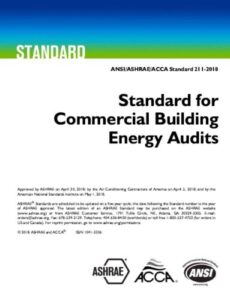ASHRAE Standard 211 – 2018 Standard for Commercial Building Energy Audits
ASHRAE Standard 211 – 2018 Standard for Commercial Building Energy Audits
ASHRAE Standard 211 – 2018 Standard for Commercial Building Energy Audits purpose is to establish consistent practices for conducting and reporting energy audits for commercial buildings. This standard
- a. defines the procedures required to perform Energy Audit Levels 1 , 2, and 3;
- b. provides a common scope of work for these audit levels for use by building owners and others;
- c. establishes consistent methodology and minimum rigor of analysis required; and
- d. establishes minimum reporting requirements for the results of energy audits.
This standard is the product of countless volunteer hours spent developing and refining it, and of numerous comments and suggestions during public review intended to improve its quality, consistency, and usability. These efforts represent a significant contribution toward reducing the energy consumption of our building stock. The committee is deeply grateful to everyone who offered their time and enthusiasm in service of this important mission.
You can also Read Process Heat Transfer Principles, Applications and Rules of Thumb
ASHRAE Standard 211 – 2018 Standard for Commercial Building Energy Audits
- Foreword
![ASHRAE Standard 211 - 2018 Standard for Commercial Building Energy Audits]()
- Purpose
- Scope
- Definitions
- Compliance Requirements
- Procedures
- Reporting
- References
- A: Compliance Form
- B: Energy Savings Calculations
- C: Reporting Forms
- D: Report Outlines
- E: Recommended Data Exchange Formats
- F: Building Energy Model Calibration
- G: Risk Analysis and Assessment Methods
- H: Informative References
The standard includes normative (required) reporting forms in Annex C. These forms are a compromise, in a sense,
as many people and organizations have very different viewpoints as to what should be reported in an energy audit. The AHJ may choose to implement the standard using these forms, by modifying them or by explicitly opting out of their use, as they see fit. The forms are included in the standard for three principal reasons:
- provide a minimum standardized reporting path to follow for local jurisdictions who do not have the resources to develop their own.
- They are designed to facilitate the use of electronic data transfer.
- They require important quality control checks on energy savings estimates.


Comments are closed.